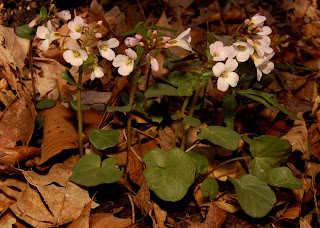I've been itching to get out and botanize lately, but I have just been too busy. Saturday was too beautiful to be anywhere
but outside, so I made sure that we walked a trail after taking our nieces to an Easter egg hunt held at Potato Creek State Park in St. Joseph County, Indiana. There wasn't very much in flower yet, but all of the signs that we saw showed that we aren't very far away.

Have you ever looked closely at
Glechoma hederacea? I'm not sure that I had, until today. This putrid, creeping weed was introduced for ornamental and medicinal purposes in the 1800s. The flowers certainly are pretty, but I can see it being more sought after as an ornamental if the flowers were two or three times the size that they are.
 Cardamine hirsuta
Cardamine hirsuta is one of those weeds that you see so often early in the year that you begin to not even notice it anymore. It flowers and goes to fruit very early in the year, and in May you can hear the seeds exploding from the siliques as you walk through a field where it is present. This mustard truly does have cute little flowers, even though it is introduced.

Another mustard,
Cardamine concatenata is native to mesic upland forests, bottomland woods, and rocky bluffs in the eastern half of the United States. You can often find this ephemeral in large colonies in somewhat degraded situations as well as in more intact systems.

Ahh,
Claytonia virginica, the genus of which was named for 18th Century botanist John Clayton, certainly is a beautiful sight in spring. Being one of the earliest blooming native plants in this part of the country, my photo library is filled with pictures of this purslane. With a range similar to the previous species, spring beauty can be found in intact woods as well as in disturbed areas such as mowed lawns. The tubers are edible (but should first be cooked), and though small, taste like potatoes.

If you're walking through the woods in April and not paying close attention to the forest floor, you may walk right past
Erigenia bulbosa. The flowers of this member of the parsely family have petals up to only 4mm long.
Erigenia litterally means "born in the spring," which is why this plant is commonly called "harbinger of spring." The tuber referenced by the specific epithet is supposedly edible, though I've never tried it.
 Caltha palustris
Caltha palustris, one of the more gaudy of the spring wildflowers, is often found in swamps, seeps, and along creeks. It is difficult to
not notice this plant in April as you drive past wet areas, as the golden glow given off by a colony of marsh marigolds grabs your attention. This buttercup is native in the northern half of North America, as well as in Eurasia. (By the way, check out that tiny insect hanging out on the petal-like sepal.)
I hope you've all had a chance to get out already this spring. As of few of you have mentioned to me, the spring is developing slowly this year, giving even the busiest of us a chance to enjoy its splendor.
















































.jpg)



